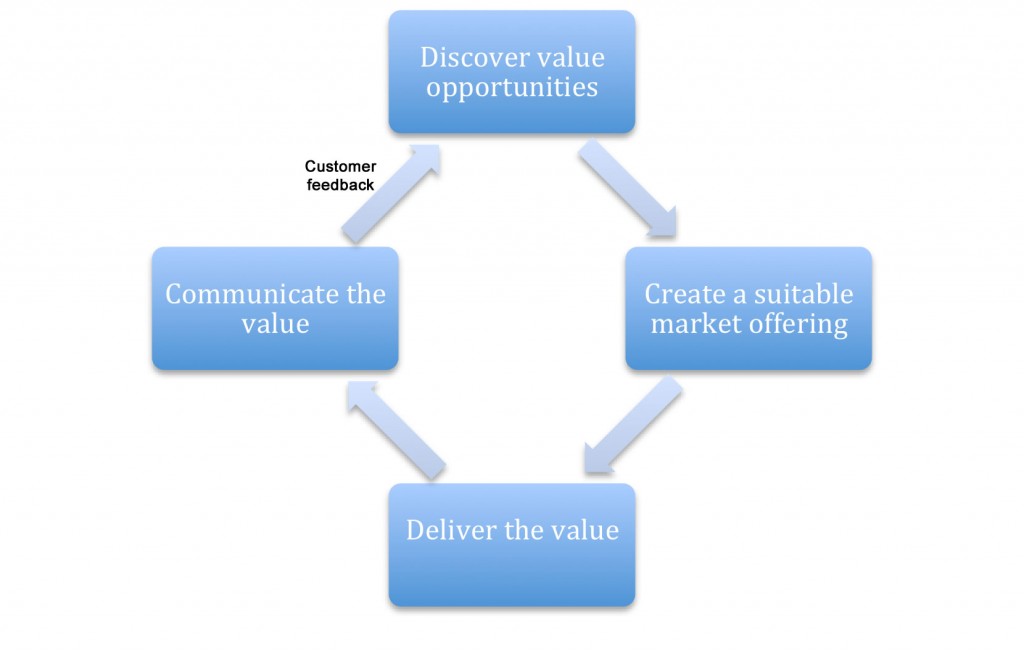What is customer value?
Customer value is the satisfaction the customer experiences (or expects to experience) by taking a given action relative to the cost of that action.
The given action is traditionally a purchase, but could be a sign-up, a vote or a visit, while the cost refers to anything a customer must forfeit in order to receive the desired benefit, such as money, data, time, knowledge.
Think about the following definition of marketing:
Marketing creates, communicates, and delivers value to customers.
Your internal chain of sourcing, operations, processes, sales, marketing, and customer service all contribute to the creation of value. So do your support operations such as HR and accounting. All of these components affect your customers directly or indirectly in some way, informing their perception of you.
And this leads to the fundamental point: The results of your efforts to create value are measured in the customers’ perception of that value.
People do not buy things because you like them. They buy them because they like them, or need them.
More importantly, in this world of choice:
Customers compare their perceived value of similar products when making a decision.
Whether you are deciding on a restaurant to visit, your next car, or which digital marketing agency you want to use, there are choices available and many factors play a part in forming that decision.
Customer value is all about subjective perceptions, which can only be influenced, not controlled. This gives accountants nightmares. It’s why I love marketing!
Measuring Customer Value
There are many equations and models for measuring customer value. The simplest is this:
Perceived Value = Perceived Benefits / Cost
In other words, for a given set of benefits, as the cost rises, the perceived value drops.
This is an important point. Value does not refer to price. It refers to the perceived benefits stood to be gained in the context of price. Cost is only part of the equation. Literally.
Two identical products with identical exposure can only compete on cost. Two differentiated products do not have to compete on cost. Products are not just differentiated by their features. They can also be differentiated because of their brand. If Toyota brings out a car, you may presume it’s reliable because one of its key brand features is reliability. If another carmaker releases a near-identical car, they may struggle to compete because they do not share the same customer perceptions.
The same applies to content marketing. For example:
Perceived Value of “The Web Marketers Guide to Reddit” = Learning / Time
The perceived value of your latest blog post can be measured by the reader’s perceived benefit of reading the content (e.g. learning) relative to the time it took for them to gain that benefit.
The Drivers of Value
Take this list:
- Product function
- Points of differentiation
- Quality
- Service
- Marketing
- Branding
- Price
- Existing relationships or experience
- Personal bias from experience and upbringing
These are drivers that impact a customer’s perception of value. Some you can control, some you cannot. For any individual customer they will rank differently in importance. Some people love brands. Some people only buy cheap. Some favor short form content. Some people treasure personal relationships.
I’ve previously talked about audience segmentation. The fragmentation of customer value is one of the primary reasons for segmentation. By identifying groups of people with shared values you can start to create products and messages that resonate.
What can you do?

The Customer Value Delivery Cycle
- Think of everything you do in terms of delivering value to your customers and audience with the understanding that they have choices and you are not the only choice.
- Understand your market well enough that you can break it down into individual segments with unifying characteristics that will respond in the same way to a given value proposition.
- Always look for the opportunity to create new value propositions. If you sit on your laurels, your competition won’t.
- Look for avenues to communicate this value at the right time and in the right place.
- Listen to your customers. Learn their perceptions about what you offer. Do not hesitate to change based on what you learn. The customer, in this case, is always right.
Finally, consider this article. It is my hope that these words give you something to think about, a simple takeaway that will impact your business in some meaningful way.
In other words, I am seeking to provide value, as do all the other authors at Builtvisible.com. By demonstrating expertise, and by sharing some of that expertise we are looking to influence your perception of us in a positive way.
Content marketing is, after all, nothing more than creating, distributing, and communicating value. And for the customer feedback, we have a comments section below!
